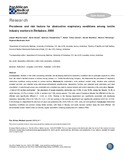Please use this identifier to cite or link to this item:
https://cris.library.msu.ac.zw//handle/11408/979Full metadata record
| DC Field | Value | Language |
|---|---|---|
| dc.contributor.author | Mberikunashe, Joseph | - |
| dc.contributor.author | Sarah, Banda | - |
| dc.contributor.author | Addmore, Chadambuka | - |
| dc.contributor.author | Gombe, Notion, T. | - |
| dc.contributor.author | Gerald, Shambira | - |
| dc.contributor.author | Tshimanga, Mufuta | - |
| dc.contributor.author | Matchaba-Hove, Reginald | - |
| dc.date.accessioned | 2016-04-24T11:01:45Z | - |
| dc.date.available | 2016-04-24T11:01:45Z | - |
| dc.date.issued | 2010 | - |
| dc.identifier.issn | 1937- 8688 | - |
| dc.identifier.uri | http://hdl.handle.net/11408/979 | - |
| dc.description.abstract | Workers in the cotton processing industries risk developing obstructive respiratory conditions due to prolonged exposure to cotton dust. We noted a tenfold increase in asthma among workers in a Textile Manufacturing Company. We determined the prevalence of respiratory obstructive conditions among workers in various sections. Methods We conducted a cross sectional analytic study. Workers were randomly sampled and data was collected using interviewer-administered questionnaires. Respiratory function was assessed using spirometry and chest auscultation. A walk through survey was conducted and a checklist was used to capture hazards and control measures in the work place. Results A total of 194 workers participated. The prevalence of severe respiratory obstruction was 27.8%. It was 50.0% among the blowers, 35.3% in waste recovery, 32.5% in carders, 15.0% in spinners and 7.5% among weavers. The mean years of exposure between the affected and the non-affected were significantly different (T =2.20; p< 0.05). Working in the blowing department was significantly associated with developing respiratory obstruction (OR=3.53; 95% CI= 1.61-7.79) but working in the weaving department was significantly protective (OR 0.16; CI 0.04-0.59).Working in a department for less than 10 years was protective (OR =0.94; 95% CI= 0.48-1.85), but not significant. Conclusion Obstructive respiratory conditions are common among textile workers, with those in blowing and waste recovery sections being the most affected. We recommended worker rotation every six months, regular spirometric screening employment of a medical officer. | en_US |
| dc.language.iso | en | en_US |
| dc.publisher | African Field Epidemiology Network | en_US |
| dc.relation.ispartofseries | Pan Africa Medical Journal;Vol. 6, No. 1; p. | - |
| dc.subject | Respiratory obstruction, cotton dust, spirometry, Zimbabwe | en_US |
| dc.title | Prevalence and risk factors for obstructive respiratory conditions among textile industry workers in Zimbabwe, 2006 | en_US |
| dc.type | Article | en_US |
| item.fulltext | With Fulltext | - |
| item.openairecristype | http://purl.org/coar/resource_type/c_18cf | - |
| item.languageiso639-1 | en | - |
| item.grantfulltext | open | - |
| item.openairetype | Article | - |
| item.cerifentitytype | Publications | - |
| Appears in Collections: | Research Papers | |
Files in This Item:
| File | Description | Size | Format | |
|---|---|---|---|---|
| pamj-06-01.pdf | 104.13 kB | Adobe PDF |  View/Open |
Items in MSUIR are protected by copyright, with all rights reserved, unless otherwise indicated.



